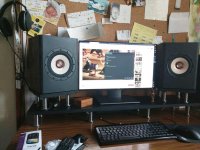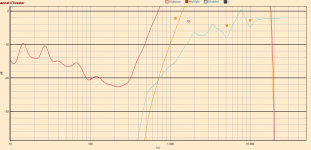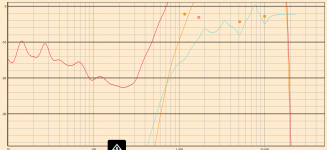I’m not sure how to read the graphs, but if the light blue line (on tweeter page) is the filter applied, You are seriously stressing the hell out of that tweeter by boosting 10dB well under natural cutoff. If that is the case it looks like the xover frequency should be considerably higher such that the tweeter gets better operating conditions.
But I might be miss reading the chart ...
But I might be miss reading the chart ...
Yes, it's a big boost but it is before applying the lr4 high pass at 1.7khz. So at 500hz, the tweeter is actually way down. It serves to flatten the response around 800-1000hz.
It's still probably not the greatest for overall output, but a set of monitors for a computer are almost exclusively relegated to near field use so the power demands are quite low.
Ok, here's a possible fix. The blue line is the filter applied to the tweeter, crossover included. Post 59/60 have an overall view.
The first filter is with the current boost at 500hz (q=3, +10db). I can replace it by a gentler 675hz boost (q=1, +3db).
Would that seem more reasonable ?
The first filter is with the current boost at 500hz (q=3, +10db). I can replace it by a gentler 675hz boost (q=1, +3db).
Would that seem more reasonable ?
Attachments
Almost over now.
I measured the speakers this evening. I used HFD for the initial measurements and the crossover design and REW for the validation. I managed to invert the wiring of a woofer apparently... It's a good thing that a simple tick box allows me to clean that mistake without opening the box again.
The crossover is a LR4 at 1.7khz, after EQing the woofer and tweeter flat about one octave high/low.
The measurements were taken with the speaker at 2.15 height, the mic on axis about 75cm away, all walls at more than 3m. That should give me a relatively clean bass response up to 80hz. The three rew measurements are at 0°-25°-45° (obviously they're spaced away).
There is obviously a rise off axis between 6 and 10khz. I'll have to measure that again with the speakers in position and see how to mitigate that.
This speaker looks like a very good concept and not less impressive the implementation.
Excellent on- and off-axis response except the rise below 8kHz, this definitely would be visible (and audible ofc.) in the power response.
Ime it's worth to sacrifice some on-axis linearity to get a more linear power response. So first, i would try to disable the +3dB boost at 7700Hz, measure the on- and off-axis again, say in 5-6 steps and do a power average (if you can) from the curves. Try to get a more linear acoustic power average.
I don't know if this will improve the sound at that relatively short listening distance, but I think it's worth a try.
Regards!
Thank you a lot for having a look at it and the suggestions. I should have some time on Sunday to move them back to the big room for some more measurements. This gives me the occasion till then to learn about power average. 😉
I've also found this page about reflections due to the mic stand on Troels Gravesen's website. I'm going to try to improve the measuring setup.
I've also found this page about reflections due to the mic stand on Troels Gravesen's website. I'm going to try to improve the measuring setup.
- Status
- Not open for further replies.
- Home
- Loudspeakers
- Multi-Way
- Speakers for a computer desk against a wall ?


